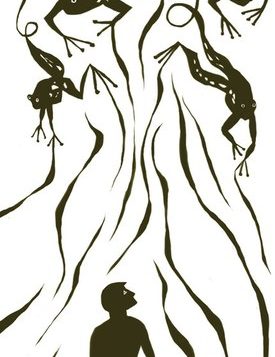 Illustration by Rebeka Ryvola
Illustration by Rebeka Ryvola
A wildlife biologist returns to a childhood stomping ground, devoid of its once-plentiful amphibians.
Back then, they were known as mountain yellow-legged frogs, though when I first saw them in an alpine meadow, taxonomy wasn’t exactly on my mind. It was the 1970s, and I was just a boy out exploring while my grandparents set up a picnic table at their favorite Forest Service campground near Mount Rose, just north of Lake Tahoe. At least once every summer, they’d drive up for the afternoon. I remember the tablecloth, the pines and firs ringing the campsite, the aroma of the barbecue. But mostly I remember the frogs.
They weren’t the tree frogs I routinely saw back home in the Bay Area. They were slightly larger, and an unremarkable earth-tone in color. What made them so memorable was their abundance. Walking along the stream in the meadow, I flushed several with every step. There were hundreds, possibly thousands; I had never seen so many frogs. As a curious boy fascinated by wild things, this place was better than anything I’d ever known. I don’t think I’ve ever been happier.
But the years of picnics and frogs were brief. When I became a teenager, I spent less and less time at family outings. By the time I got my driver’s license I was off on my own, exploring elsewhere. And I never saw those frogs again.
Time was not kind to mountain yellow-legged frogs. Their numbers plummeted. The California Department of Fish and Wildlife had introduced trout in numerous high-country lakes and streams, and those fish gobbled up tadpoles with gusto. Worse, chytrid fungus, an introduced pathogen, arrived like the amphibian equivalent of the Black Death. In one watershed after another, frogs disappeared. The population on the flanks of Mount Rose was the only one known in Nevada, but sometime before 2000 it, too, had vanished. Those frogs surely played a role in my decision to return to school for a degree in conservation biology. I read about their demise through the distance of field guides and journals.
~
In the early 2000s both my grandparents passed away, and that got me reminiscing about our picnics and those frogs, which are now known as Sierra Nevada yellow-legged frogs (Rana sierrae). Genetic analysis concluded that those inhabiting the Northern and Central Sierra were distinct from populations in the Southern Sierra and the mountains of Southern California. The species was split in two. Both were eventually listed under the Endangered Species Act, but not before the Sierra Nevada yellow-legged frog had vanished from over 90 percent of
its range.
~
In September 2016, I found myself drawn back to that childhood campsite. I’d done some summer reading, thoughtful pieces on place and time. Maybe it was only nostalgia, but I felt the urge to acknowledge those long-ago outings, which, like so many good things in life, had ended almost unnoticed.
Escaping the pall of the Soberanes Fire and the heat of the lowlands, I headed to the mountains. Finding the place again, however, proved tricky. I didn’t know the campground’s name and had only a general sense of where it was. Nothing looked familiar on the drive toward Mount Rose, until, near the summit, I recognized a spur road and campground sign. The campground had recently closed for the year, its gate locked. I parked by the road and walked in. Several roads branched out just beyond the entrance. A golden-mantled ground squirrel scolded me, and looking past it, I saw the old campsite. It had been rejuvenated — new picnic table and grill, a bear-proof trash receptacle instead of the old metal garbage cans — but the trees looked just as I remembered.
Beyond, the meadow beckoned. In my boyhood memory it went on forever, but this clearing was hardly longer than a football field. I walked out into it, eyes groping for something familiar. Yet it was my feet that remembered first: I stepped onto some moss and sank, just as I’d done here as a boy who had wondered if he’d hit quicksand. Just ahead lay the stream’s headwaters, a rivulet barely a foot wide. Flecks of granite and pyrite sparkled in its clear, shallow water, and just beyond, at the confluence of another tiny stream, was a boulder I recognized like a long-lost friend. Suddenly, everything fell into place, except for the frogs. And without them, how could this place ever again mean anything to a 10-year-old?
My head and heart battled over what to do next. The heart won. For the next hour, I scoured that stream, my heart searching for frogs my head knew were long gone. I returned to the boulder. Something monumental happened to me here all those years ago, and I was torn between jubilation and despair. There’s no adjective to describe it; it was akin to bittersweet, but amplified. The time for picnics had passed; both the frogs and my grandparents were gone. But the trees, campsite, and meadow were still here, and so was I.
Joseph Belli is a wildlife biologist who writes from Pacheco Pass in central California. He is the author of The Diablo Diary, a collection of essays from California’s
Diablo Range.
